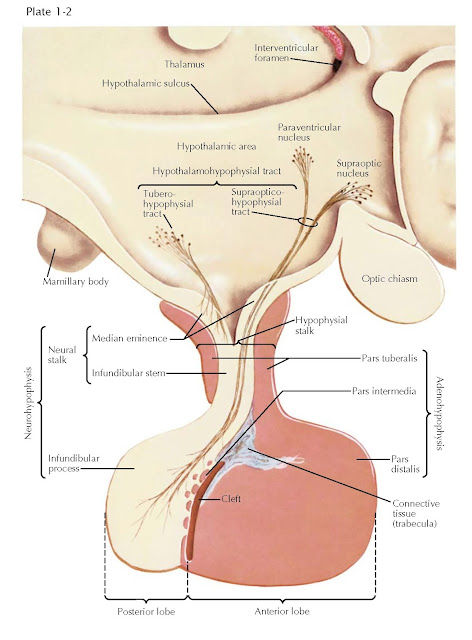DIVISIONS OF THE PITUITARY GLAND
AND RELATIONSHIP TO THE HYPOTHALAMUS
The pituitary
gland (hypophysis) is composed of the neurohypophysis (posterior pituitary
lobe) and adenohypophysis (anterior pituitary lobe). The neurohypophysis
consists of three parts: the median eminence of the tuber cinereum,
infundibular stem, and infundibular process (neural lobe). The adenohypophysis
is likewise divided into three parts: the pars tuberalis, pars intermedia, and
pars distalis (glandularis). The infundibular stem, together with portions of
the adenohypophysis that form a sheath around it, is designated as the
hypophysial (pituitary) stalk. The extension of neurohypophysial tissue up the
stalk and into the median eminence of the tuber cinereum constitutes
approximately 15% of the neurohypophysis. A low stalk section may leave enough
of the gland still in contact with its higher connections in the
paraventricular and supraoptic nuclei to prevent the onset of diabetes insipidus.
Atrophy and disappearance of cell bodies in the supraoptic and paraventricular
nuclei follow damage to their axons in the supraopticohypophysial tract. If the
tract is cut at the level of the diaphragma sellae, only 70% of these cells are
affected; if the tract is severed above the median eminence, about 85% of the
cells will atrophy. Thus, approximately 15% of the axons terminate between
these levels.
The main nerve supply, both functionally and anatomically, of the
neurohypophysis is the hypothalamo-hypophysial tract in the pituitary stalk. It
consists of two main parts: the supraopticohypophysial tract, running in the
anterior or ventral wall of the stalk, and the tuberohypophysial tract in the
posterior, or dorsal, wall of the stalk. The tuberohypophysial tract originates
in the central and posterior parts of the hypothalamus from the paraventricular
nucleus and from scattered cells and nuclei in the tuberal region and mamillary
bodies. The supraopticohypophysial tract arises from the supraoptic and paraventricular
nuclei. On entering the median eminence, it occupies a very superficial
position, where it is liable to be affected by basal infections of the brain
and granulomatous inflammatory processes. The tuberohypophysial tract in the
dorsal region of the median eminence is smaller and consists of finer fibers. In
the neural stalk, all the fibers congre- gate into a dense bundle lying in a
central position, leaving a
peripheral zone in contact with the pars tuberalis, which is relatively free of
nerve elements. The hypothalamohypophysial tract terminates mainly in the
neurohypophysis.
The hypothalamus has ill-defined boundaries. Anteroinferiorly, it is
limited by the optic chiasm and optic tracts; passing posteriorly, it is
bounded by the posterior perforated substance and the cerebral peduncles. On
sagittal section, it can be seen to be separated from the thalamus by the
hypothalamic sulcus on the wall of the third ventricle. Anteriorly, it merges
with the pre- optic septal region, and posteriorly, it merges with the
tegmental area of the midbrain. Its lateral relations are the subthalamus and
the internal capsule.
A connective tissue trabecula separates the posterior and anterior lobes
of the pituitary; it also extends out into the anterior pituitary lobe for a
variable distance as a vascular bed for the large-lumened artery of the trabecula.
The embryonic cleft, which marks the site of the Rathke pouch within the gland,
may be contained, in part, in this trabecula. It is easier to see in newborns and
tends to disappear in later life. Colloid-filled follicles in the adult gland
mark the site of the pars inter- media at the junction between the pars
distalis and the neurohypophysis. This boundary may be quite irregular because
fingerlike projections of adenohypophysial tissue are frequently found in the
substance of the neurohypophysis.





